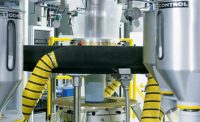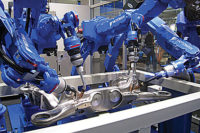The advent of laboratory automation systems has made a significant impact on clinical diagnostics, drug discovery, food and agricultural research, and forensics. Indeed, consulting firm Markets and Markets predicts that global sales of lab automation will grow at a cumulative annual rate of 6.7 percent over the next five years, topping $5.1 billion by 2020.
Lab automation spares technicians from monotonous, repetitive tasks, and it keeps them from handling hazardous substances. Automation also enables laboratories to operate 24/7, and it increases the quality, reproducibility and traceability of samples.
Among the world’s leading suppliers of laboratory automation is Anton Paar GmbH, based in Graz, Austria. One of the company’s top products is the Modular Sample Processor, a robotic workcell that automatically prepares small samples of liquids, pastes or powders for analysis. The cell is equipped with two gantry robots. One dispenses amounts ranging from a few milliliters to 1 deciliter into small containers. The other transfers containers to and from input and output trays, a scale, and a bar code reader.
The cell can operate as a standalone machine; it can be connected to an analytical instrument; or it can be integrated into a fully automated processing line.
Laboratories use the cell to automate “time-consuming manual work, such as pipetting, sampling, dosing and weighing,” explains Markus Schöllauf, a project manager in Anton Paar’s Automation and Robotics Div.
Motion control components from Fest Corp. ensure the machine meets Anton Paar’s requirements for accuracy, repeatability and smooth motion.
Each gantry robot consists of two electric linear actuators. The X-axis is the Model DGEA cantilevered linear actuator with a toothed-belt drive. The Y axis is the Model EGSK linear actuator with a ballscrew drive. Both axes are powered by Model EMMS-ST stepper motors.
The DGEA cantilevered axis is driven by a pinion fixed in the slide. The belt runs around the pinion, giving it a shape like the Greek letter omega. This allows the actuator to produce high torque. For better dynamic response, the motor, gearing and drive head are permanently mounted—only the main profile moves with the load. The particularly flat design of the drive head reduces vibration.
The device is available in stroke lengths of 800, 900 and 1,000 millimeters. Maximum load ranges from 7 to 27 kilograms, while maximum feed force ranges from 230 to 1,000 newtons. The actuator’s top speed is 3 meters per second. Repeatability is ±0.05 millimeter.
With its compact design and solid steel housing and guide rail, the EGSK is good for short-stroke, high-precision applications requiring high rigidity, long service life and good repeatability. The EGSK has a recirculating ball bearing guide and offers several ballscrew pitches for different performance requirements.
The EGSK comes in five versions. Stroke lengths range from 25 to 800 millimeters. Maximum speed ranges from 330 to 1,050 millimeters per second, and repeatability ranges from 3 to 10 microns.
Besides its linear axes, the dispensing robot is equipped with a small Model AEN pneumatic cylinder. When a pipetting procedure has finished, the cylinder actuates to eject the used pipette into a waste chute.
The AEN cylinder is compact. In fact, it uses up to 50 percent less space compared with standard ISO 6431 cylinders. A unique three-component piston improves running characteristics and cushioning. It also saves on fitting space, which has been used for a longer piston-rod bearing. The result is greater guide precision and higher load capacity to resist lateral forces. The cylinder is available in diameters ranging from 12 to 125 millimeters.
“Festo didn’t just supply us with the axes, but rather a complete system solution, including a CECC Codesys controller,” says Schöllauf. “Without that, it would not have been possible for us to meet our extremely short development deadline of four months.”
Using a single controller to govern all axes of motion ensures that the gantries will never collide even though they move within the same workspace.




